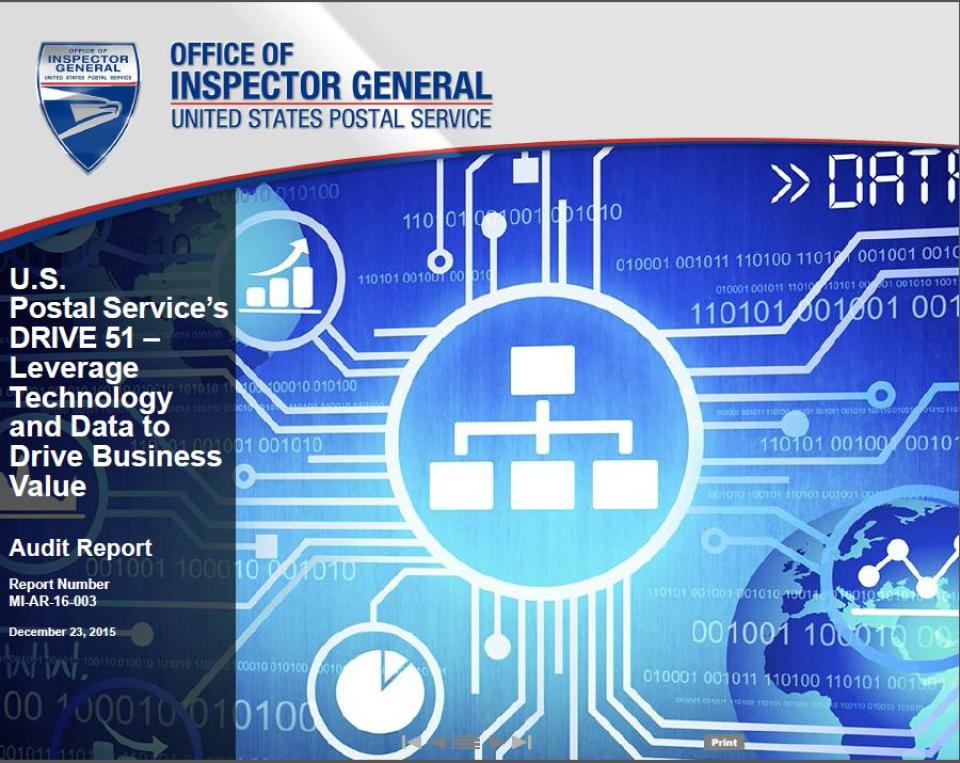U.S. Postal Service's DRIVE 51 – Leverage Technology and Data to Drive Business Value
Background
In fiscal year (FY) 2011, the U.S. Postal Service established 36 Delivering Results, Innovation, Value, and Efficiency (DRIVE) initiatives to improve its business strategy. DRIVE was established to reduce a reported $20 billion gap between revenue and expenses through strategic initiatives with measurable outcomes.
DRIVE Initiative 51 – Leverage Technology and Data to Drive Business Value consists of five projects to streamline the development of emerging technologies. The Postal Service’s goal is to use technology to meet its revenue, expense, operational efficiency, service, and customer experience goals by FY 2019.
Our objective was to determine whether DRIVE Initiative 51 used established DRIVE project management processes.
What the OIG Found
DRIVE Initiative 51 managers did not follow established DRIVE project management processes. Specifically, the charter did not identify metrics to measure whether DRIVE Initiative 51 is helping the Postal Service meet its performance and financial goals. We determined that 22 of the 33 charter metrics measured the deployment or implementation of equipment, systems, and processes rather than the performance and savings resulting from those new systems. As an example,
DRIVE Initiative 51 managers included a Small Package Sorting System deployment metric to measure progress towards their goal of modernizing package automation, but did not include a metric to monitor performance. We conducted our own performance analysis and determined the labor savings were about $2 million (29.8 percent) less than the projected $6.7 million during the period June 20 through September 30, 2015.
DRIVE Initiative 51 managers also did not follow processes for updating the Technology Management Office System and managing milestones. For example, 74 changes to project milestones were made in the system without authorization. We also identified two roadmaps with gaps of more than 2 months between milestone dates. DRIVE guidance requires milestones at 4- to-6-week intervals.
These issues occurred because the Strategic Management Office did not ensure DRIVE governance and documentation procedures were followed. As a result, there is an increased risk that DRIVE Initiative 51 will not help the Postal Service meet its business performance goals and the Executive Leadership Team will not be able to accurately evaluate the initiative.
We issued a report in 2013 that outlined 34 best practices to institutionalize data governance and a three-phase implementation strategy for the Postal Service. Management agreed with our previous recommendation to implement an enterprise-wide data governance program and indicated
that they would address it in a DRIVE initiative. However, management did not implement these practices or the strategy for DRIVE Initiative 51, making it more difficult for the Postal Service to improve management of critical data. That recommendation will remain open until an enterprise-wide data governance program is established.
What The OIG Recommended
We recommended management ensure all DRIVE Initiative 51 metrics measure business performance, include all metrics in the Technology Management Office System, and establish an independent review process to validate the accuracy of system inputs. We also recommended DRIVE managers set milestones at 4- to-6-week intervals, document all necessary approvals when changing initiative and project goals, and establish goals in DRIVE Initiative 51 that will create an enterprise-wide data governance program for the Postal Service.

